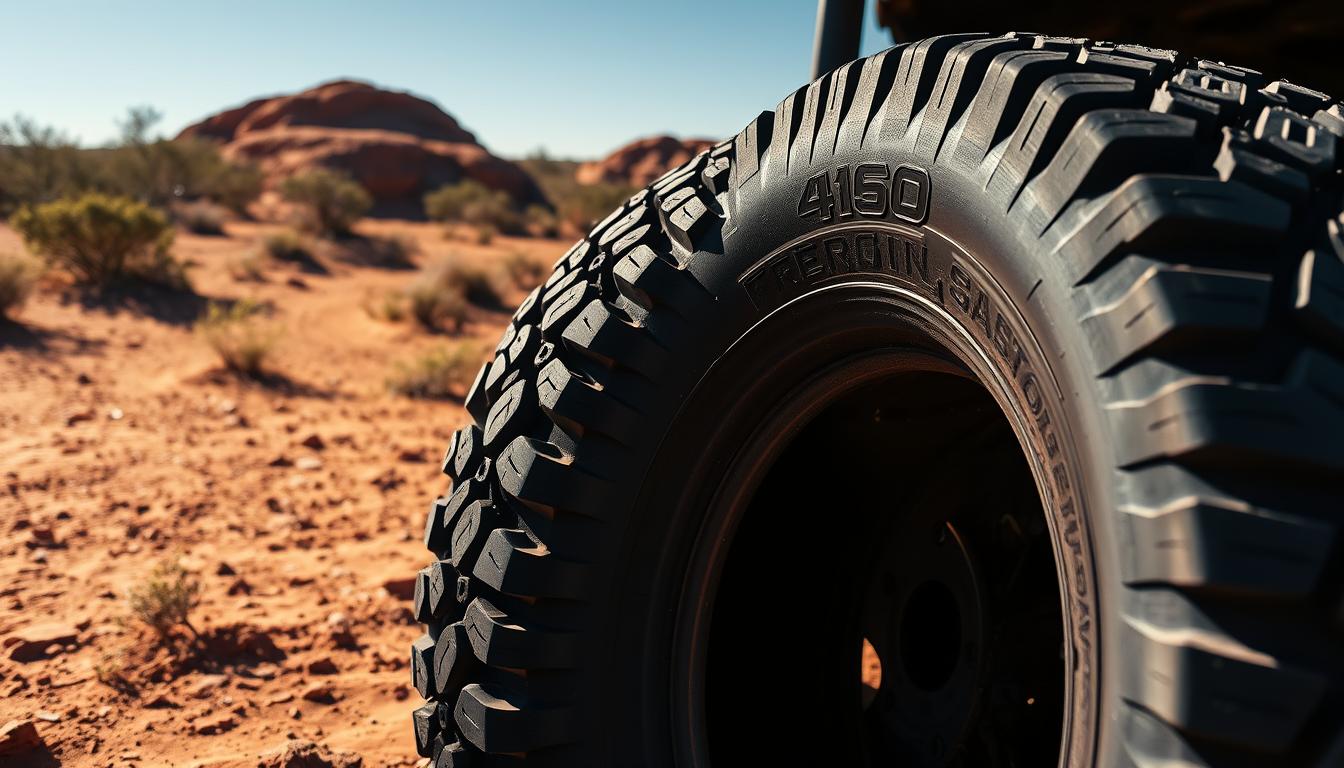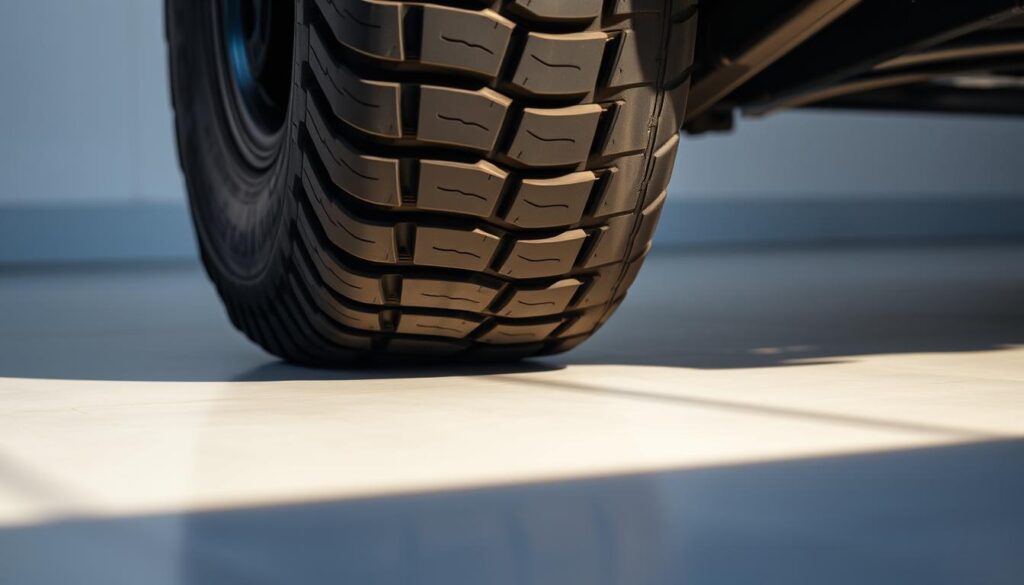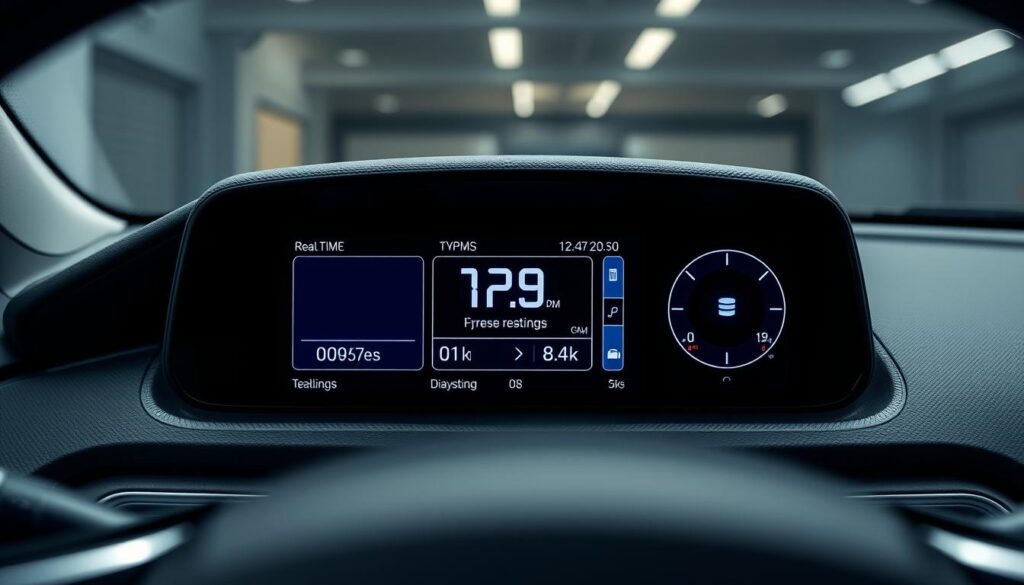4×4 Tyres in Australia: What You Must Know

Choosing the right 4WD tyres is key for Aussie 4WD owners. The right tyre can greatly affect how your vehicle performs on and off the road.
It’s important to know the basics of 4×4 tyres and their uses. With so many options out there, Aussie 4WD owners need to know the best Tire Selection Tips. This helps them make a smart choice.
Key Takeaways
- Understanding 4WD tyres is vital for Aussie 4WD owners.
- The right tyre selection impacts vehicle performance.
- Various tyre options are available for different driving conditions.
- Tire selection tips can help owners make informed decisions.
- 4WD tyres play a significant role in safety and driving experience.
Understanding 4×4 Tyre Basics
For every Aussie 4WD owner, knowing the basics of 4×4 tyres is key. They’re made for different terrains and conditions. This includes paved roads and rough off-road trails.
What Makes 4×4 Tyres Different?
4×4 tyres are not like standard tyres. They’re tougher and better at gripping the ground. They’re built for off-road driving, handling rough terrains and extreme weather.
Key features of 4×4 tyres include:
- Reinforced sidewalls for added strength and protection against punctures
- Aggressive tread patterns for improved traction on various surfaces
- Specialized rubber compounds for enhanced durability and grip
Common Types of 4×4 Tyres
There are three main types of 4×4 tyres: Mud Terrain (M/T), All Terrain (A/T), and Highway Terrain (H/T). Each type meets different driving needs and preferences.
Mud Terrain (M/T) Tyres: Perfect for extreme off-road conditions. M/T tyres have aggressive tread patterns for maximum traction in muddy and rocky terrains.
All Terrain (A/T) Tyres: A/T tyres balance on-road comfort with off-road capability. They’re great for drivers who use paved roads and off-road trails.
Highway Terrain (H/T) Tyres: H/T tyres are best for on-road driving with some off-road use. They offer a comfortable ride and good handling on paved roads.
Tyre Construction and Materials
The materials and construction of 4×4 tyres are vital for their performance and durability. Modern 4×4 tyres use advanced materials and techniques. This improves their strength, traction, and driving experience.
Key materials and construction features include:
- Advanced rubber compounds for improved durability and grip
- Reinforced tyre cords for added strength and stability
- Specialized tread designs for optimized traction and handling
Choosing the Right Tyre for Your 4WD
Choosing the right 4×4 tyre is important. It affects how well your vehicle performs, whether on the road or off it.
Key Factors to Consider
When picking 4×4 tyres, think about your driving habits, the terrain you usually drive on, and your vehicle’s specifications. For off-road driving, you need tyres with aggressive tread and strong build.
If you mostly drive on roads, look for tyres that are comfortable and fuel-efficient. Knowing what you need is the first step in finding the right tyre.
Popular Brands and Models
Many top brands make quality 4×4 tyres. Yokohama, Maxxis, and Continental are well-known for their performance and durability.
When picking a tyre model, think about what’s most important to you. This could be tread life, handling, or how well it resists punctures.
Off-Road vs. On-Road Options
Choosing between off-road and on-road tyres is a big decision. Off-road tyres are better for rough terrains, giving you more grip and durability.
On-road tyres are smoother on highways but might not handle unsealed roads as well.
So, your choice depends on where you drive most and your driving habits.
The Importance of Tyre Pressure
Proper tyre pressure is key for your 4WD’s performance. It improves handling on roads and traction off-road. Keeping the right pressure is essential for safety, efficiency, and performance.
Recommended Pressure Settings
The right tyre pressure for your 4WD depends on where you drive. For off-road, lower pressure helps with grip and avoids tyre damage. On roads, higher pressure is better for handling and saving fuel. Always check your vehicle’s manual for the best pressure for your 4WD.
Effects of Incorrect Tyre Pressure
Wrong tyre pressure can harm your 4WD’s performance and safety. Under-inflated tyres use more fuel, wear out faster, and handle poorly. Over-inflated tyres lose grip, risk damage, and wear unevenly. It’s important to check your tyre pressure regularly.
Key risks of wrong tyre pressure include:
- Reduced tyre life due to uneven wear
- Increased fuel consumption
- Compromised handling and safety
- Increased risk of tyre damage, off-road
How to Check and Maintain Pressure
Checking and keeping tyre pressure right is easy. You’ll need a good tyre pressure gauge and a compressor for changes. Always check pressure when tyres are cold, as driving warms them up. Regular checks are part of good 4WD care for safety and performance.
Tips for maintaining tyre pressure:
- Check tyre pressure monthly and before long trips
- Use a high-quality tyre pressure gauge for accurate readings
- Adjust pressure based on terrain and driving conditions
- Keep your tyre pressure gauge and compressor in good condition
Tyre Treads Explained
Every 4WD owner in Australia needs to know about tyre treads. The tread pattern and depth are key for performance. They affect how well your vehicle handles on roads and off.
Understanding Tread Patterns
Tyre tread patterns are made for different conditions. Deeper treads with aggressive patterns are best for off-road driving. They give the needed grip on rough terrains.
Shallower treads with less aggressive patterns are better for on-road use. They improve handling and save fuel.
The Role of Tread Depth
Tread depth is very important for tyre performance and safety. A deeper tread means better grip and control, even on slippery surfaces. As the tread wears, the tyre’s grip weakens, raising the risk of accidents.
| Tread Depth | Performance Impact | Safety Implications |
|---|---|---|
| New Tyre (8-10mm) | Excellent traction and control | High safety level |
| Partially Worn (4-7mm) | Reduced traction, but manageable | Moderate safety risk |
| Worn Out (<3mm) | Poor traction, handling problems | High safety risk |
When to Replace Your Tyres
It’s important to know when to replace your tyres. Most makers say to replace them at 1.6mm tread depth. But for 4WDs, it’s wise to replace them sooner, if you drive off-road a lot.
“Regular tyre maintenance is not just about safety; it’s also about ensuring your vehicle performs at its best.” –
Understanding tyre treads and keeping your tyres in good shape boosts your 4WD’s performance and safety. This is true whether you’re driving on roads or off-road.
Seasonal Tyre Considerations
Knowing what your 4WD tyres need in different seasons is key. Australia’s weather changes a lot, so picking the right tyres is vital. It affects how well your vehicle performs and stays safe.
Best Tyres for Summer Adventures
In the Australian summer, tyres wear out quicker because of the heat. Summer tyres are made to handle the heat and dry conditions. They give better grip and control on hot roads.
When going on summer adventures, choose tyres that can handle the heat and off-road challenges. This includes sandy dunes and rocky tracks.
Preparing for Winter Conditions
Even though snow is rare in most of Australia, some places get colder in winter. If you drive in these areas or visit colder places, winter tyres are a good choice. They help you stay safe on icy or snowy roads.
Winter tyres stay flexible in cold weather. This improves your grip and reduces the chance of skidding.
All-Season vs. Dedicated Seasonal Tyres
Choosing between all-season tyres and seasonal tyres depends on your driving and the weather. All-season tyres work well in many conditions without needing to change tyres often.
Dedicated seasonal tyres are made for specific weather. They perform better in their designed environment. For many Australian 4WD owners, all-season tyres are a good choice. But, if you drive in extreme conditions often, seasonal tyres might be better.
Maintenance Tips for 4×4 Tyres
Keeping your 4WD tyres in check is key for off-road fun. Regular care boosts your tyres’ life and your vehicle’s performance and safety.
Regular Inspection Practices
It’s vital to check your tyres often for wear and damage. Look for uneven wear, cuts, or bulges. Also, check the tread depth and for debris in the tread.
Key inspection areas include:
- Tyre tread depth
- Sidewall condition
- Presence of cracks or bulges
- Signs of uneven wear
Rotation and Alignment
Rotating your tyres regularly helps them wear evenly. Do this every 8,000 to 12,000 kilometers. Also, keep your wheels aligned to avoid uneven wear and ensure your vehicle handles well.
Benefits of proper rotation and alignment include:
- Extended tyre life
- Improved vehicle handling
- Enhanced safety
- Better fuel efficiency
Signs of Wear and Damage

- Reduced tread depth
- Uneven wear patterns
- Cracks in the sidewall or tread
- Bulges or blisters on the tyre surface
By following these tips, your 4×4 tyres will stay in great shape. This means safer and more fun driving. For more on 4WD Tyres Australia, talk to a pro for advice on tyre care and choice.
Upgrading vs. Replacing Tyres
Choosing to upgrade or replace your 4×4 tyres can greatly affect your vehicle’s off-road skills and overall performance. It’s key to check your current tyres, think about your driving needs, and consider your budget.
When to Upgrade Your Tyres
Upgrading your 4×4 tyres can boost your vehicle’s off-road performance. If your tyres are worn out or not right for the terrain, it’s time to think about upgrading. Also, if you’ve made changes to your vehicle for more power, new tyres can be a smart choice.
Upgrading is also a good idea if you switch from on-road to off-road tyres or the other way around. For example, if you drive more on rough terrains, upgrading to tyres made for off-road use can improve your vehicle’s grip and last longer.
Costs vs. Benefits of Upgrading
Upgrading your 4×4 tyres has many benefits, but you must consider the costs. High-quality off-road tyres might cost more, but they last longer and perform better. Think about the long-term savings and benefits, like less chance of tyre failure and better fuel use, when deciding.
- Improved off-road capability
- Better durability and performance
- Enhanced safety features
Sourcing High-Quality Replacement Tyres
When upgrading or replacing, finding high-quality tyres is essential. Look for well-known brands that focus on 4×4 tyres and read reviews from other 4WD owners. Make sure the tyres fit your vehicle and are right for your driving conditions.
When buying, think about tread depth, tyre build, and materials. Making an informed choice will keep your 4WD reliable and perform well, on and off the road.
Legal Requirements for 4×4 Tyres
If you own a 4WD in Australia, knowing the legal rules for 4×4 tyres is key. Following these rules helps avoid fines and keeps you safe on the road.
Understanding Local Regulations
Australia has laws for 4×4 tyres, like load and speed ratings. It’s important for 4WD owners to know these rules to stay legal and safe.
Local rules can change, so always check with local transport authorities for the latest info. This includes knowing about tyre tread depth, condition, and any needed certifications for your area.
Tyre Standards and Certifications
Tyre standards ensure tyres are safe and perform well. For 4×4 tyres, they must meet Australian Standards (AS) or international ones like ETRTO.
Certifications like the Australian Tyre Rating Scheme help show a tyre’s performance and safety. Knowing these standards helps 4WD owners choose the right tyres.
Safety Implications of Non-Compliance
Not following legal tyre rules can be very dangerous. Non-compliant tyres can make your vehicle less safe, increase the risk of tyre failure, and even cause accidents.
Also, ignoring these rules can lead to fines and penalties. Regular checks against legal and safety standards can help avoid these risks and make driving safer.
| Tyre Standard | Description | Importance for 4WD Owners |
|---|---|---|
| Load Rating | Specifies the maximum weight a tyre can support. | Ensures the tyre can handle the vehicle’s weight and any additional load. |
| Speed Rating | Indicates the maximum speed a tyre is designed for. | Critical for safety, as exceeding this speed can lead to tyre failure. |
| Tread Depth | Measures the depth of the tyre tread. | Adequate tread depth is essential for traction and safety, specially in off-road conditions. |
The Role of Tyre Pressure Monitoring Systems (TPMS)
Tyre Pressure Monitoring Systems (TPMS) have changed how we look after our 4WD tyres. They give us real-time pressure info. This helps avoid underinflation, which can cause tyre failure, and overinflation, which can reduce traction.

Benefits of Using a TPMS
Using a TPMS brings many advantages, like better safety and longer tyre life. It’s very useful for off-road adventures. It offers real-time monitoring and alerts for tyre pressure problems early on.
For more info on TPMS for your 4WD, check out this guide. It dives deep into TPMS benefits and how it works.
How to Select the Right TPMS
Choosing the right TPMS for your 4WD needs careful thought. Look at compatibility, accuracy, and extra features like temperature monitoring. Make sure it’s made for off-road use and can handle your adventures.
- Check if it fits your vehicle’s tyre size and setup.
- Choose systems known for their accuracy and reliability.
- Think about extra features that might improve your off-roading.
Common Issues with TPMS
Even with its many benefits, TPMS can have problems like sensor failures and system errors. Regular upkeep and checks can help fix these issues. This keeps your TPMS working right.
Knowing how TPMS works and how to use it well can greatly improve off-roading safety and tyre care for 4WD owners.
Off-Roading Challenges and Solutions
Off-roading in Australia comes with its own set of challenges. It needs careful planning and the right gear. For 4WD owners, knowing how to tackle tough terrains and picking the right tyres is key to a great off-roading adventure.
Navigating Tough Terrain
Driving through mud, sand, and rocks tests your skills and your vehicle’s strength. Adjusting tyre pressure is a must for different terrains. Lower pressure helps on soft surfaces like sand or mud, while higher pressure is better for rocky areas where you need to avoid punctures.
Experts say, “The right tyre pressure can make all the difference between getting stuck and navigating through challenging terrain with ease.”
“Tyre pressure is not a one-size-fits-all setting; it’s about adapting to the terrain.”
Tyre Selection for Off-Road Use
Picking the right tyres for off-road adventures is essential for better performance and safety. The Best 4×4 Tyres are made for off-road, balancing traction, durability, and resistance to punctures. Think about the terrain you usually drive on when choosing tyres.
- For muddy terrains, tyres with aggressive tread patterns are ideal.
- For sandy or rocky terrains, tyres with a more robust construction and appropriate tread depth are recommended.
Tips for Enhancing Performance
Improving off-road performance is more than just the right tyres. It’s also about driving techniques and keeping your vehicle in top shape. Driving slowly and smoothly helps a lot on tough terrains. Regularly check and maintain tyre pressure and ensure your vehicle is aligned properly for the best performance.
With the right gear and smart driving, 4WD owners can face off-roading challenges head-on with confidence.
Environmental Impact of Tyres
The production and disposal of 4×4 tyres are big issues for the environment. As more 4WD vehicles are bought in Australia, the impact of their tyres grows. This is a big worry.
Sustainable Production Methods
Now, tyre makers are focusing on making things better for the planet. They use green materials, cut down on waste, and make their processes more efficient. Some are even using recycled rubber in their tyres.
Eco-Friendly Disposal Options
It’s important to get rid of tyres in a way that’s good for the environment. Eco-friendly disposal options include recycling and reusing tyres. Recycling tyres helps reduce waste and saves natural resources.
Tyre Recycling Initiatives
More and more tyre recycling programs are starting up around the world. These programs collect old tyres, turn them into raw materials, and then use these materials for things like building or fuel. Recycling tyres helps clean up the environment and saves resources.
| Initiative | Description | Benefits |
|---|---|---|
| Tyre Recycling | Collecting and processing used tyres into raw materials | Reduces landfill waste, conserves natural resources |
| Eco-Friendly Disposal | Environmentally responsible disposal methods | Minimizes environmental impact |
| Sustainable Production | Using eco-friendly materials and processes in tyre manufacturing | Reduces carbon footprint, promotes eco-friendly practices |
By using green practices in making and getting rid of tyres, the 4WD world can lessen its harm to the environment. As buyers, picking 4WD Tyres Australia products that are good for the planet and supporting Tire Selection Tips that help the environment can really help.
Conclusion: Make Informed Decisions
Aussie 4WD owners now know a lot about 4×4 tyres. They understand everything from the basics to advanced topics. This knowledge helps them make better choices for their off-road adventures and on-road safety.
Key Takeaways for Enhanced 4WD Experience
It’s important for 4WD owners to understand the factors we’ve discussed. This includes picking the right tyre, keeping the right tyre pressure, and knowing about tyre treads. By following these tips, owners can greatly improve their off-roading adventures.
Staying Ahead with the Latest Off-Roading Advice
Learning more and keeping up with new tyre technologies and best practices is key. This way, owners can tackle tough terrain with confidence and safety.
By making smart choices and staying current with Off-Roading Advice, Aussie 4WD owners can have a safer and more fun 4WD experience.
FAQ
What are the main types of 4×4 tyres available for Aussie 4WD owners?
There are three main types of 4×4 tyres. M/T (Mud-Terrain) tyres are for rough off-road use. A/T (All-Terrain) tyres work well on various terrains. H/T (Highway-Terrain) tyres are best for smooth roads.
How do I choose the right 4×4 tyre for my vehicle?
Think about how you drive and the places you go. Also, check your vehicle’s details like tyre size and load rating. This helps pick the right tyre for you.
What is the importance of tyre pressure for 4×4 tyres?
Tyre pressure is key for 4×4 tyre safety and performance. Adjust it based on where you’re driving. Lower pressure is good for off-road, higher for roads.
How often should I check and maintain my 4×4 tyre pressure?
It’s important to check tyre pressure often. Do it at least once a month. Also, before long trips and when changing driving conditions.
What are the signs that indicate my 4×4 tyres need to be replaced?
Look for worn tread, uneven wear, and damage. Also, check for age-related wear. Regular checks can spot these issues early.
Are there specific tyre considerations for off-roading in Australia?
Yes, choose tyres made for off-road use. Adjust pressure for the terrain. Drive slow and use the right gear for better traction.
What are the environmental implications of 4×4 tyre disposal?
Disposing of 4×4 tyres can harm the environment. But, recycling tyres is a better option. It reduces waste and environmental impact.
Do I need a Tyre Pressure Monitoring System (TPMS) for my 4WD?
A TPMS is good for tyre health and safety. It shows real-time pressure data. This helps avoid tyre failure and keeps your vehicle safe.
What are the legal requirements for 4×4 tyres in Australia?
Aussie 4WD owners must follow local tyre laws. This includes using tyres that meet standards. Knowing these rules is important for road safety and avoiding fines.
Can I upgrade my 4×4 tyres, and what are the benefits?
Upgrading can improve your 4×4’s performance and life. But, choose high-quality tyres that fit your vehicle. Consider your driving needs and budget too.





